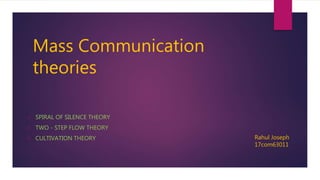
Mass communication theories
- 1. Mass Communication theories • SPIRAL OF SILENCE THEORY • TWO - STEP FLOW THEORY • CULTIVATION THEORY Rahul Joseph 17com63011
- 2. Spiral of silence Originally proposed by German political scientist Elisabeth Noelle-Neumann in 1974. Founder & President of “World Association for Public Opinion Research” in 1978 to 1980 Through this theory Neumann indirectly explains the Jews status during World War II under Nazi’s control. Here, Adolf Hitler dominated the whole society and the minority Jews became silent due to the fear of isolation or separation.
- 3. Spiral of silence – The theory The one view dominated the public scene and others disappeared from the public awareness as it adherents became silent. the people fear of separation or isolation those around them, they tend to keep their attitudes to themselves when they think they are in the minority. the tendency of people to remain silent when they feel that their views are in opposition to the majority view on a subject. Example – Change in work hours from 8 – 10 hours, majority accept.
- 4. Why do they remain silent ? Fear of isolation Fear of Rejection – personal opinion / public opinion Withdrawal / Lack of support The spiral is created or reinforced when someone in the perceived opinion majority speaks out confidently in support of the majority opinion, hence the minority begins to be more and more distanced from a place where they are comfortable to voice their opinion and begin to experience fear The media plays an important role in this process, especially in dictating or perceptually dictating the majority opinion.
- 5. The spiral
- 6. Advantages & Disadvantage Advantages Micro level and Macro level explanatory process Works well during public campaigns Majority view if positive can impact Beliefs, common norms of people are made known raise question about considering the role and responsibility of media in the society. Disadvantages Minority view not considered Induces fear of isolation Super imposed opinions by media Essence of diversity is lost Media can have negative influence in shaping opinions View can be silenced or withdrawn
- 7. Two step flow theory – History First introduced by Paul Lazarsfeld, Bernard Berelson, and Hazel Gaudet in The People's Choice, a 1944 study focused on the process of decision-making during a Presidential election campaign Purpose These researchers expected to find reasons for the direct influence of media messages on voting intentions ( Presidential elections) . They were surprised to discover, however, that informal, personal contacts were mentioned far more frequently than exposure to radio or newspaper as sources of influence on voting behavior. Armed with this data, Katz and Lazarsfeld developed the two- step flow theory of mass communication.
- 8. Two – step flow model information from the media moves in two distinct stages. First, individuals (opinion leaders) who pay close attention to the mass media and its messages receive the information Opinion leaders pass on their own interpretations in addition to the actual media content Opinion leaders are quite influential in getting people to change their attitudes and behaviors The two-step flow theory has improved our understanding of how the mass media influence decision making. The theory refined the ability to predict the influence of media messages on audience behaviour.
- 9. Multi – step flow theory A theory that indicates that information, usually from media outlets, moves in multiple directions, each consumer of the information passing on not only the information but their own interpretation of it. Introduced by Paul Lazerfeld in 1994, elaborated by Elihu Katz 1955 Also known as diffusion of innovations theory. Concept : this theory is an improvisation over two step theory, tries to overcome its limitations, it goes through several channels of interpretation before it reaches the targeted user. Opinion leaders interfere between media’s direct message and audience’s reaction. Leaders influence opinions more strongly than formal media. Influence can be upwards, downwards, peer to peer or even backwards.
- 10. Cultivation theory Cultivation theory (sometimes referred to as the cultivation hypothesis or cultivation analysis) was an approach developed by Professor George Gerbner, dean of the Annenberg School of Communications at the University of Pennsylvania. He began the 'Cultural Indicators' research project in the mid-1960s, to study whether and how watching television may influence viewers' ideas of what the everyday world is like. Cultivation research is in the 'effects' tradition. It is one of the core theories of media effects. According to the theory, people who watch television frequently are more likely to be influenced by the messages from the world of television. The influence goes to such an extent that their world view and perceptions start reflecting what they repeatedly see and hear on television. Television is,therefore, considered to contribute independently to the way people perceive social reality.
- 11. Cultivation theory Cultivation research looks at the mass media as a socializing agent and investigates whether television viewers come to believe the television version of reality the more they watch it.
- 12. Mean world syndrome Mean world syndrome is a term coined by George Gerbner to describe a phenomenon whereby violence-related content of mass media makes viewers believe that the world is more dangerous than it actually is. Mean world syndrome is one of the main conclusions of cultivation theory. Effects Make people believe their neighbourhood is unsafe Induces fear of being victimized by crime Assume crime rates are on the rise even when that’s not true